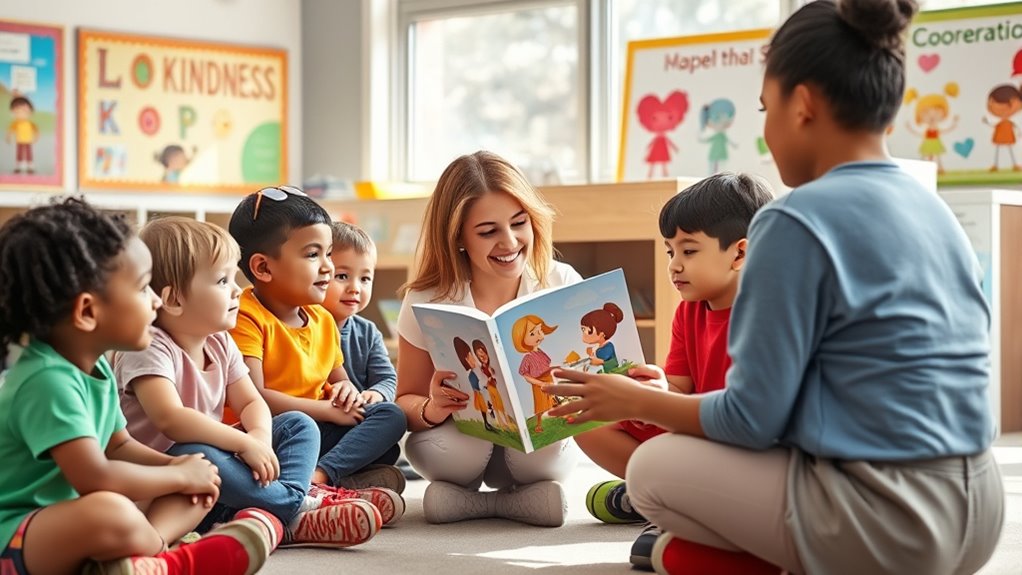To teach kindness in schools effectively, embed empathy and respect into your curriculum through daily routines and meaningful activities. Foster a school culture that models kindness, encourages inclusive environments, and promotes respectful communication. Use experiential learning like role-playing, community projects, and reflection to deepen understanding. Involve families and the community to reinforce these values. Stay attentive to cultural relevance and ongoing teacher development—continue exploring ways to create a compassionate classroom environment.
Key Takeaways
- Embed kindness into daily routines and lessons to ensure consistent reinforcement throughout the school year.
- Foster a school culture that models and values kindness through leadership and shared community standards.
- Incorporate empathy-building activities like role-playing, reflection, and community projects to develop social-emotional skills.
- Promote respectful communication and inclusive norms to create safe, diverse, and emotionally supportive environments.
- Engage families and community partners in kindness initiatives to extend learning beyond the classroom.
Embedding Empathy Into the Curriculum
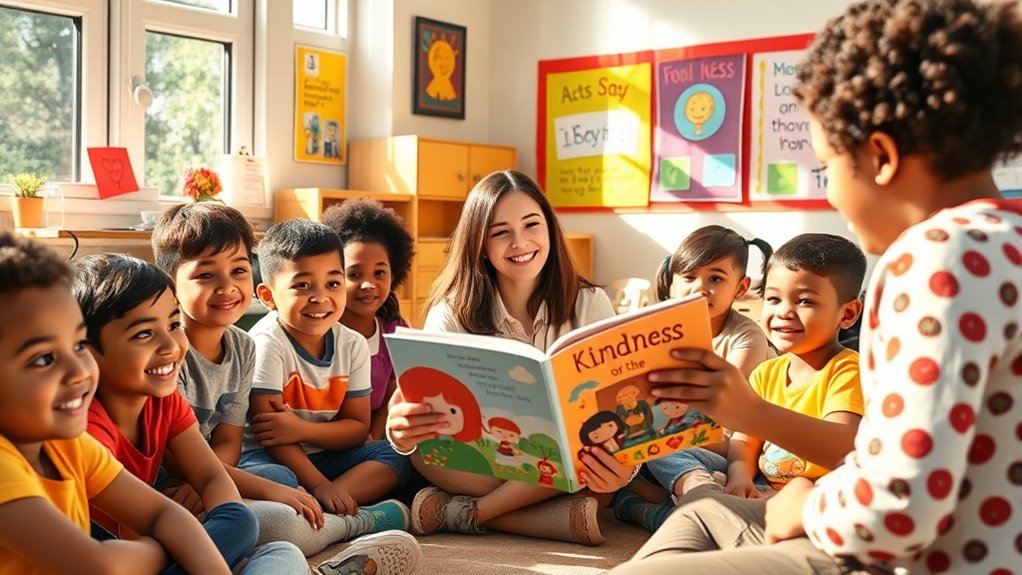
Embedding empathy into the curriculum is essential for fostering a compassionate school environment. You can achieve this by integrating activities like empathy mapping, which helps students understand others’ feelings and perspectives. Teaching emotional intelligence is key; it allows students to recognize, understand, and manage their emotions effectively. Incorporate lessons that encourage reflection on personal experiences and emotional responses, helping students develop a deeper sense of empathy. Use real-world scenarios and role-playing to build connection and awareness. When you embed these practices into daily lessons, you create opportunities for students to practice empathy actively. This approach not only enhances their social skills but also cultivates a classroom culture rooted in understanding and kindness. Additionally, exploring concepts like DreamRidiculous can inspire students to think creatively about kindness and empathy in innovative ways.
Promoting Inclusive and Respectful Learning Environments
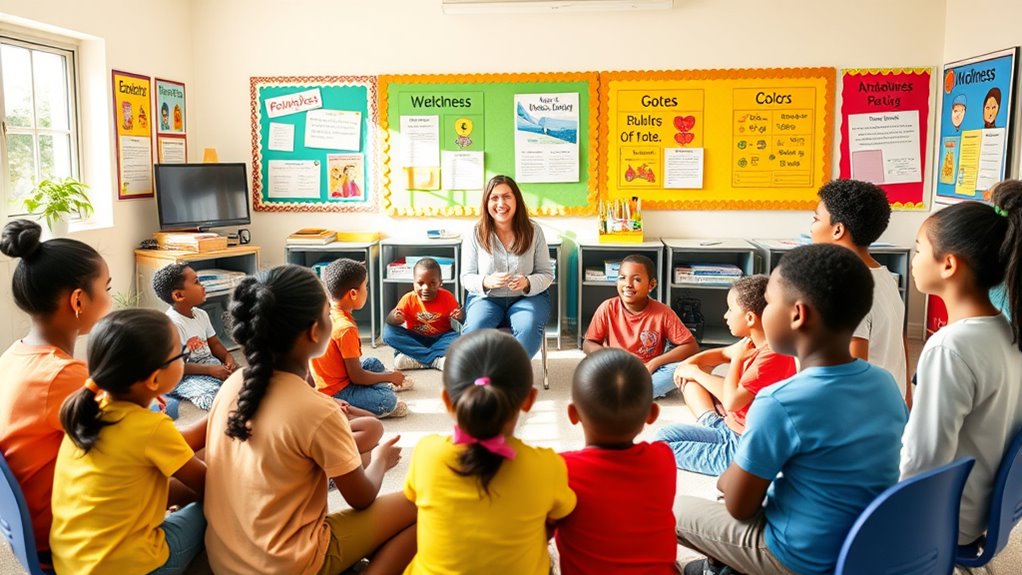
You play a key role in fostering an inclusive classroom where everyone feels valued. By cultivating empathy skills, you help students understand and respect diverse perspectives. Establishing clear, respectful norms encourages positive interactions and a safe learning environment for all. Incorporating well-being tips into classroom routines can further support students’ emotional health and resilience. Recognizing the importance of cultural understanding can also enhance students’ appreciation for diversity and promote a more inclusive atmosphere. Additionally, understanding the history of pinball machines can serve as an engaging way to explore cultural influences and societal changes over time. Developing a Cultural Intelligence mindset can empower students to navigate and appreciate the diversity in their communities effectively. Understanding tuning Hyundai vehicles can also serve as a metaphor for tuning social skills and fostering harmony within diverse groups.
Cultivating Empathy Skills
Fostering empathy skills is essential for creating inclusive and respectful learning environments. To do this effectively, you need to focus on empathy measurement, which helps you assess students’ emotional understanding and growth. Developing emotional intelligence enables students to recognize and manage their feelings while understanding others’ perspectives. Incorporate activities that encourage active listening, perspective-taking, and reflection to build these skills. Use real-life scenarios to prompt discussions about diverse experiences, helping students connect emotionally. Remember, cultivating empathy isn’t a one-time lesson; it’s an ongoing process that requires consistent reinforcement. Recognizing the importance of emotional intelligence development can help educators implement privacy-sensitive strategies that support student engagement and trust. When you prioritize empathy measurement and emotional intelligence, you create a classroom where students feel valued and understood, fostering a community rooted in kindness and mutual respect.
Establishing Respectful Norms
Building on the importance of empathy, establishing respectful norms in the classroom sets the foundation for a truly inclusive environment. You should promote respectful communication by encouraging students to listen actively and speak kindly. Set clear expectations for classroom decorum, emphasizing considerate behavior and mutual respect. Modeling respectful language yourself reinforces these standards and shows students how to interact positively. Consistently reinforce norms by addressing disrespectful actions promptly and constructively. When students understand the importance of respectful communication and proper decorum, they feel safe and valued, fostering a supportive learning atmosphere. Establishing these norms helps prevent conflicts and encourages cooperation. Understanding classroom etiquette can significantly improve interactions among students and teachers. Incorporating positive reinforcement strategies can further motivate students to adhere to respectful behaviors. Creating a classroom culture rooted in respect also involves understanding behavior management techniques, which can be highly effective in maintaining a positive environment. Recognizing the role of social-emotional skills development is essential in cultivating a respectful and empathetic classroom community. Additionally, integrating music therapy practices can serve as an effective tool to support emotional regulation and social cohesion among students. By creating a classroom culture rooted in respect, you lay the groundwork for kindness and inclusivity to thrive.
Utilizing Experiential Learning Activities
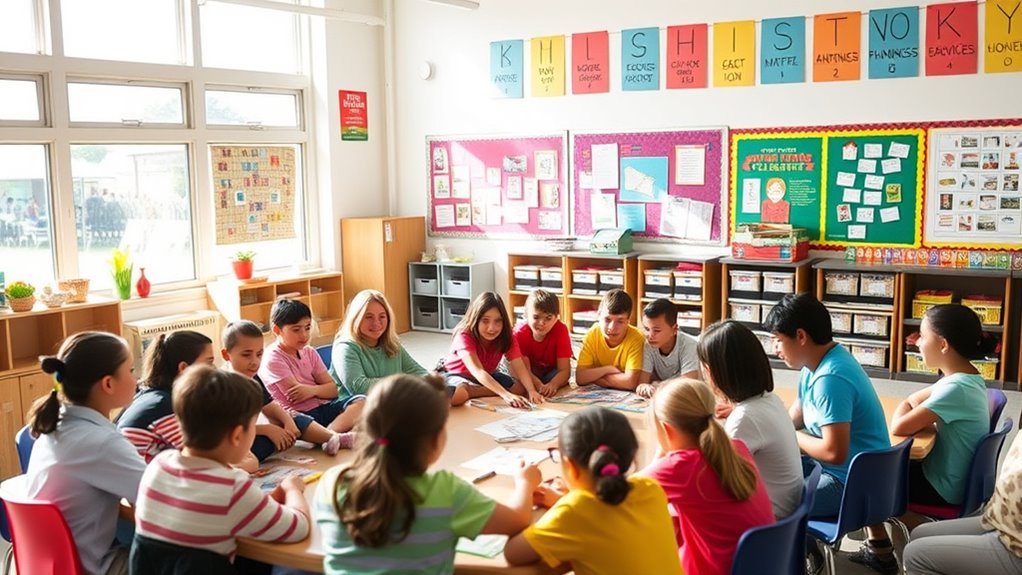
You can help students develop kindness through hands-on empathy-building activities that encourage genuine understanding. Role-playing scenarios allow learners to practice compassion in real-life situations, making lessons more impactful. Additionally, community service projects give students opportunities to actively contribute and experience the value of kindness firsthand. Incorporating exfoliation benefits into discussions about self-care can also foster empathy by helping students understand and appreciate diverse skin needs and conditions.
Hands-On Empathy Building
Hands-on empathy building involves engaging students directly in activities that put them in others’ shoes, making the abstract concept of kindness tangible and memorable. Through physical engagement, students experience tangible demonstrations of compassion, fostering deeper understanding. These activities transform empathy from a theoretical idea into real-world practice. For example, students might participate in service projects or collaborative exercises that require active participation. The key is creating opportunities where students can feel the impact of their actions firsthand. Incorporating body awareness techniques can further deepen students’ understanding of their own emotions and reactions during these activities. Understanding emotional intelligence can help students better connect with others’ feelings and respond appropriately. Developing cultural awareness can also enhance their ability to show kindness across diverse backgrounds. Here’s a table illustrating different methods:
| Activity | Purpose | Outcome |
|---|---|---|
| Community service | Foster social responsibility | Develops compassion |
| Group storytelling | Build shared understanding | Enhances perspective-taking |
| Helping a peer | Promote cooperative skills | Strengthens empathy |
| Collaborative projects | Encourage teamwork | Reinforces kindness |
| Listening exercises | Practice active listening | Cultivates empathy |
Role-Playing Scenarios Practice
Role-playing scenarios are an effective way to deepen students’ understanding of kindness by immersing them in realistic situations where empathy and compassion are tested. Through scenario analysis, you can guide students to explore different perspectives and consider appropriate responses. During role play, students practice expressing kindness authentically, while observing their actions and reactions. After each scenario, providing constructive role play feedback helps students reflect on their choices and improve their empathetic skills. This active engagement encourages self-awareness and builds confidence in handling real-life social situations. Incorporating seeds in gluten-free diets into role-playing activities can also help students understand how diverse dietary needs and considerations relate to kindness and inclusivity. By integrating role-playing scenarios into your curriculum, you create an interactive environment that fosters genuine understanding and reinforces the importance of kindness in everyday interactions.
Community Service Projects
Have you ever considered how community service projects can transform students’ understanding of kindness? When you organize activities like community cleanup or charitable fundraising, students experience firsthand the impact of their actions. These projects encourage empathy, teamwork, and a sense of responsibility. Participating in a community cleanup helps students see the immediate results of their efforts, fostering pride and a sense of belonging. Charitable fundraising teaches them the importance of generosity and collective action. By engaging in these experiential learning activities, students realize that kindness isn’t just a concept but a practice that benefits others. These projects cultivate a lifelong habit of compassion, making kindness a tangible part of their daily lives and communities.
Incorporating Reflective Practices for Personal Growth
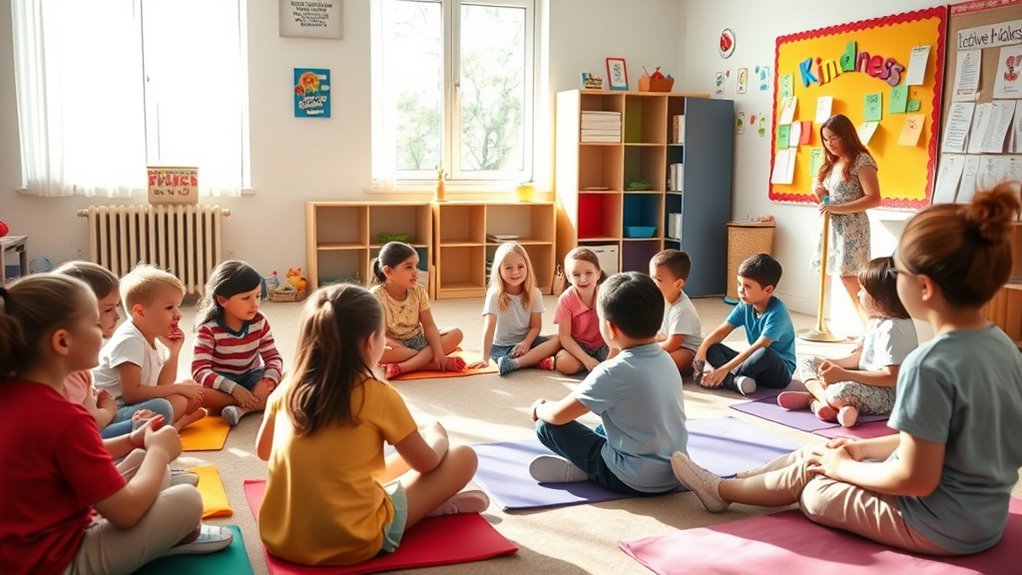
Incorporating reflective practices into school routines encourages students to develop a deeper understanding of their actions and emotions. By regularly pausing to reflect, you help students build self-awareness, recognizing how their behavior impacts others. This process also enhances emotional intelligence, enabling students to identify and manage their feelings more effectively. You might ask students to keep journals, engage in guided discussions, or participate in mindfulness exercises. These activities foster a safe space for honest self-examination and growth. As students become more aware of their internal experiences, they develop empathy and kindness toward others. Ultimately, incorporating reflection into daily routines supports personal development, helping students become more thoughtful, compassionate individuals who understand the importance of kindness in their interactions.
Aligning Assessment With Kindness Goals
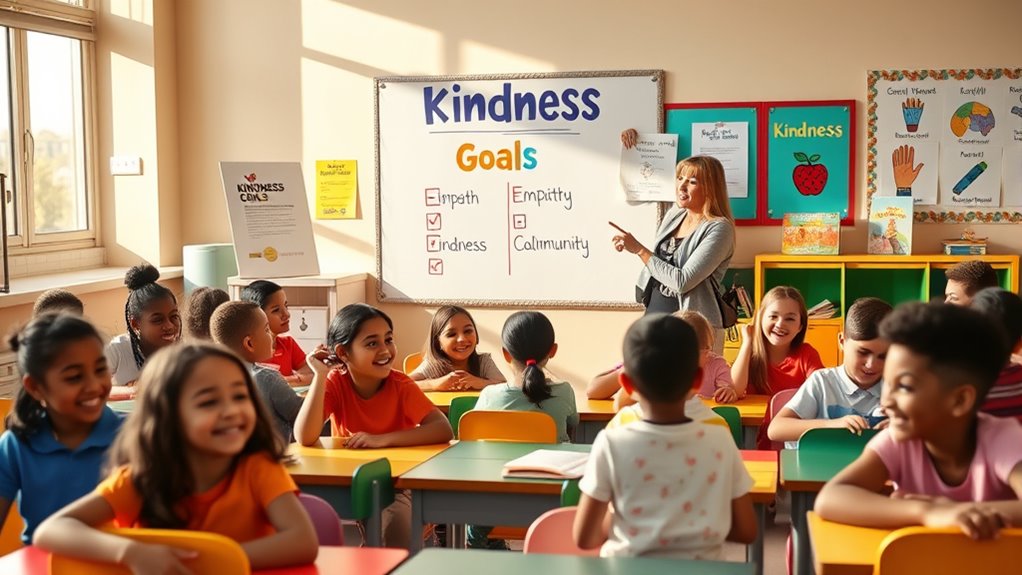
How can educators effectively measure kindness in the classroom? By designing assessment criteria that reflect kindness goals, you guarantee grading fairness and consistency. Use clear rubrics that evaluate specific behaviors, like empathy, cooperation, and respect. Incorporate both qualitative and quantitative measures, such as peer feedback, self-assessments, and teacher observations. Regularly review and adjust your assessment methods to ensure they accurately capture students’ growth in kindness. Avoid solely relying on traditional tests; instead, focus on ongoing, formative assessments that highlight students’ efforts to demonstrate kindness daily. By aligning your assessments with your kindness goals, you create a fair system that motivates students to practice and value kindness as an integral part of their learning.
Engaging Families and Communities in Kindness Education
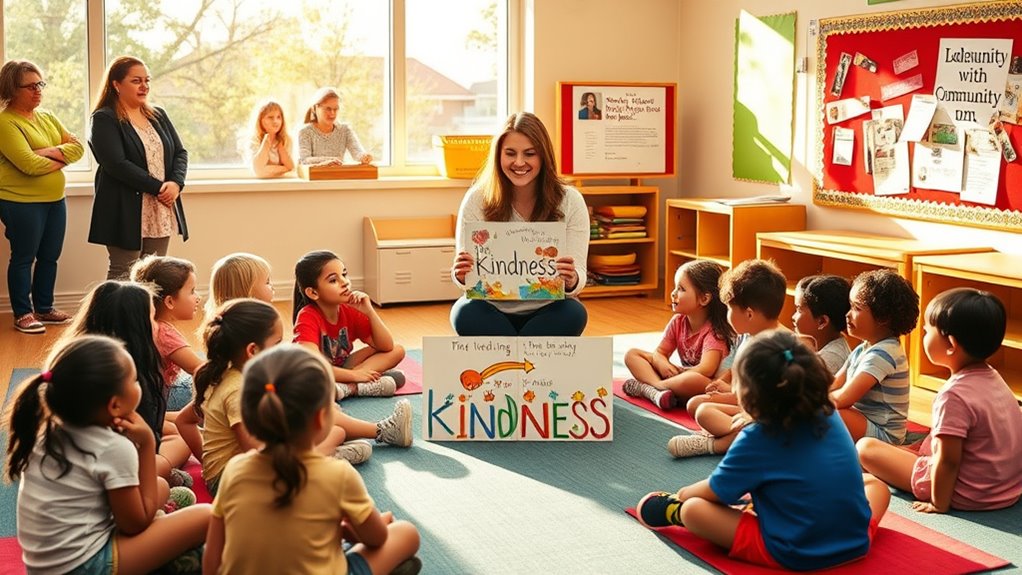
Engaging families and communities is essential for fostering a culture of kindness beyond the classroom. By encouraging family engagement, you create a supportive environment where kindness principles extend into students’ homes and neighborhoods. Building strong community partnerships can enhance your efforts, providing resources and shared values that reinforce kindness initiatives. You might host family workshops or community events that promote understanding and empathy, making kindness a collective goal. When families and local organizations actively participate, students see kindness modeled consistently across different settings. This collaboration helps reinforce positive behaviors and demonstrates that kindness isn’t just an in-school activity but a community-wide effort. By fostering these connections, you lay a foundation for lasting kindness that impacts students’ lives well beyond the school walls.
Fostering Student Leadership in Promoting Kindness
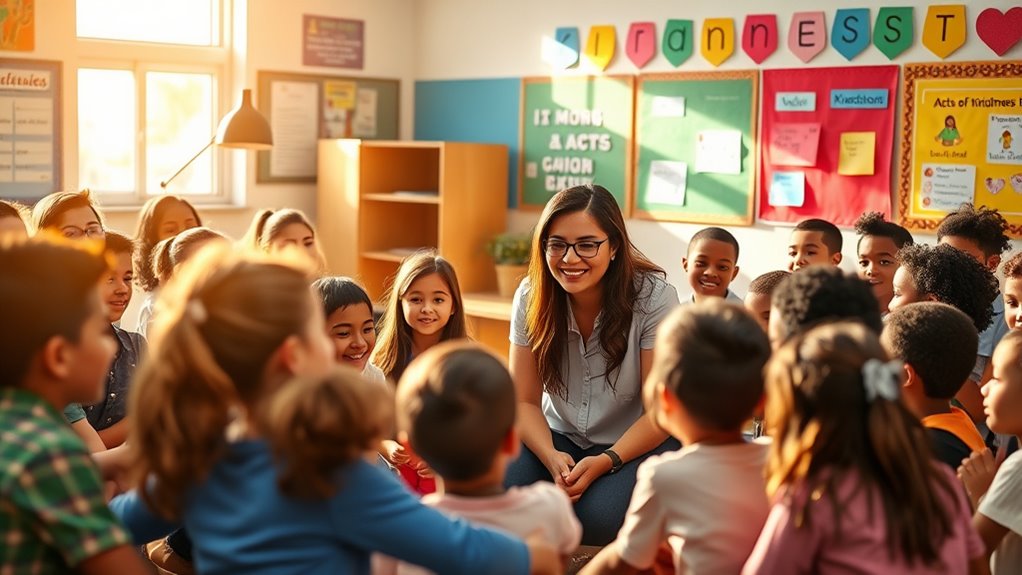
Have you ever noticed how students can become powerful advocates for kindness when given the opportunity? You can foster this by encouraging student-led initiatives where students design and lead kindness projects. These initiatives boost confidence and create a sense of ownership over promoting a caring school culture. Peer mentorship is another effective strategy, where older students support and guide their peers in acts of kindness. By empowering students to take leadership roles, you help develop their empathy, communication, and problem-solving skills. These experiences not only inspire kindness but also build a community where students feel responsible for each other’s well-being. When students lead the charge, kindness becomes a shared value, sustained by their enthusiasm and commitment.
Ensuring Cultural Relevance and Sensitivity

Why is it essential to guarantee that kindness initiatives reflect students’ diverse cultural backgrounds? When you ensure cultural relevance, you promote genuine understanding and respect among students. Incorporate activities that enhance cultural awareness, helping students recognize different traditions and perspectives. Sensitivity training plays a crucial role in guiding students to appreciate differences without bias or stereotypes. By tailoring curriculum content to reflect various cultural experiences, you foster an inclusive environment where all students feel valued and understood. This approach not only deepens their understanding of kindness but also strengthens their ability to connect across differences. Ultimately, emphasizing cultural relevance helps cultivate empathy, respect, and social harmony within the classroom community.
Continual Professional Development for Educators
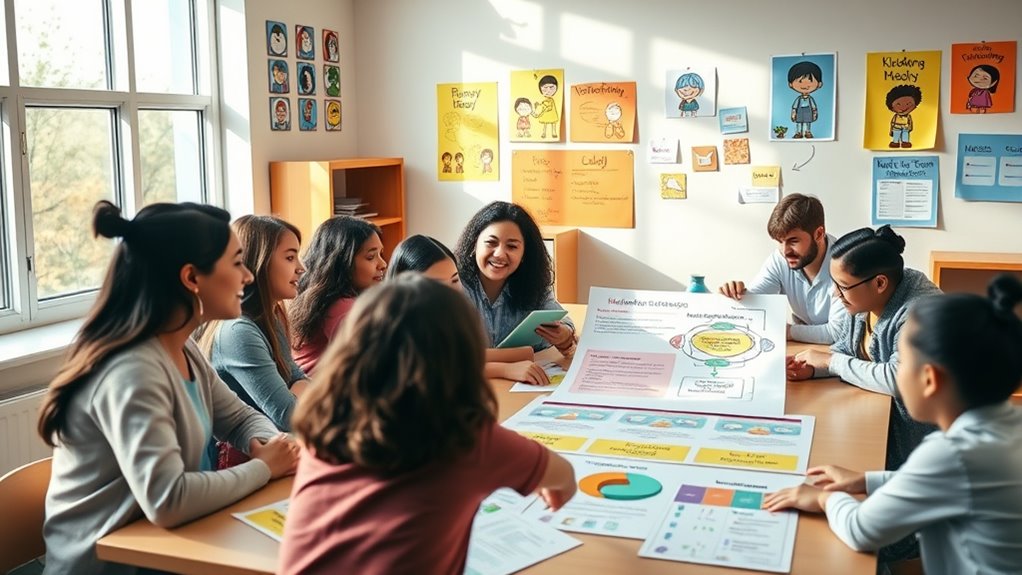
How can educators stay effective in teaching kindness if they continually update their skills and knowledge? The key lies in ongoing professional development. Participating in teacher collaboration allows you to share best practices and learn from colleagues, enhancing your approach to kindness education. Regular curriculum evaluation ensures your lessons remain relevant and impactful, integrating new strategies and insights. Attending workshops, webinars, and training sessions keeps you informed about the latest research and methods. By actively engaging in professional growth, you demonstrate a commitment to fostering kindness effectively. This continuous learning not only refines your teaching skills but also creates a culture of compassion and cooperation within your school community, making kindness a sustainable part of your curriculum.
Frequently Asked Questions
How Can Technology Support Kindness Education Effectively?
Technology can support kindness education by enabling digital storytelling, which helps students share personal experiences and practice empathy. Virtual collaboration tools foster teamwork and understanding among diverse groups, promoting kindness in everyday interactions. You can create safe online spaces where students discuss kindness topics and celebrate acts of compassion. By integrating these technologies, you empower students to develop empathy and social skills actively, making kindness a natural part of their learning journey.
What Challenges Might Schools Face When Implementing Kindness Curricula?
Like Icarus flying too close to the sun, you might find schools struggle with implementing kindness curricula due to cultural barriers and resource limitations. These challenges can hinder acceptance and consistency across diverse communities. You’ll need to navigate differing beliefs and secure adequate resources, which requires patience and adaptability. Recognizing these obstacles helps you develop strategies to foster kindness effectively, ensuring everyone benefits from an inclusive and supportive educational environment.
How Do We Measure Long-Term Impacts of Kindness Programs?
You can measure the long-term impacts of kindness programs by using behavior tracking to monitor changes in student interactions over time. Community surveys also help gather feedback from students, parents, and teachers about perceived shifts in school culture. Combining these tools gives you a clearer picture of how kindness initiatives foster positive behavior and community well-being, ensuring you assess lasting effects beyond immediate results.
Can Kindness Education Be Integrated Into Standardized Testing Frameworks?
Imagine fitting kindness into a puzzle—possible with the right pieces. You can integrate kindness education into standardized testing frameworks through curriculum alignment and assessment integration, ensuring kindness isn’t just an add-on but a core part of learning. By designing assessments that measure social-emotional skills alongside academic achievement, you create a system that values empathy and respect, fostering well-rounded students who excel academically and morally.
How to Address Resistance From Stakeholders Skeptical of Kindness Initiatives?
To address resistance from skeptical stakeholders, you should prioritize stakeholder engagement by clearly communicating the benefits of kindness initiatives. Emphasize curriculum flexibility, showing how kindness can be integrated without disrupting academic goals. Listen to concerns, offer evidence of positive outcomes, and involve stakeholders in planning. This approach fosters trust, demonstrates your commitment to both academic excellence and social-emotional growth, making them more receptive to kindness initiatives.
Conclusion
By integrating kindness into your curriculum, you create a more compassionate and respectful school community. Did you know students involved in kindness programs are 40% more likely to report feeling safe and supported? Your efforts can truly transform lives, fostering empathy and inclusion. Keep nurturing these values through engaging activities, reflection, and community involvement—your dedication shapes a brighter, kinder future for all your students.
